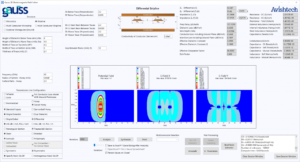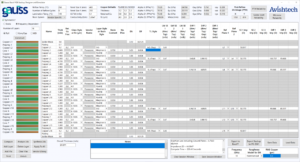
EDACafe Editorial Roberto Frazzoli
Roberto Frazzoli is a contributing editor to EDACafe. His interests as a technology journalist focus on the semiconductor ecosystem in all its aspects. Roberto started covering electronics in 1987. His weekly contribution to EDACafe started in early 2019. EDA startup Avishtech innovates PCB stack simulation and loss modeling of PCB transmission linesApril 22nd, 2021 by Roberto Frazzoli
Selecting the right construction for a PCB stack and meeting the tight loss budget of PCB transmission lines are major challenges for designers and manufacturers of high-frequency printed circuit boards. According to Avishtech – a young San Jose-based provider of innovative EDA solutions – traditional EDA tools fall short of needs in those two areas, often leading to a trial-and-error development process that translates into long design cycles and increased costs. Avishtech started addressing these problems in 2019. “That’s when me and my partners saw an opportunity to really make an impact and actually do things in a very different way,”, said founder and CEO Keshav Amla in the video interview he recently gave to Sanjay Gangal from EDACafe. “We had the right backgrounds and we felt that we were the right people to do that.” So after completing his master’s degree, in 2019 Amla left his PhD program to work on Avishtech full-time. One year later, in July 2020, the company launched its Gauss product line: Gauss Stack, a PCB stack-up design and simulation solution, and Gauss 2D, a field solver that improves transmission line loss modeling. Let’s now take a closer look at Avishtech and at the recently announced latest versions of its tools.
Challenges in PCB transmission line loss modeling As far as PCB transmission line analysis is concerned, existing EDA tools fall short of needs primarily in loss modeling, according to Amla: “Loss modeling leaves a lot to be desired in the existing solutions,” he said in the above-mentioned video interview. The analysis should also account “for ground plain losses, which are a significant portion, especially when you go well into the gigahertz range. Now you’re talking 28 gigahertz and higher frequencies. And as your dielectric thicknesses become smaller, the proximity effect becomes quite large. That’s something you can’t ignore,” Amla pointed out, “and so when you’re using other tools for loss modeling you end up thinking you have headroom, when in fact you don’t. You have designed something that doesn’t meet your loss budget requirements. We felt if we could build a tool that accurately models that, while providing all of the granularity and even higher accuracy than the other tools in the market, that would be something very powerful, a great opportunity for us.” The latest version of Gauss 2D, Avishtech’s field solver That tool is Gauss 2D, which has been recently enhanced with the addition of some new features. Besides accurate insertion loss modeling that accounts for ground plane losses, the latest version of this field solver delivers new capabilities for broadband extraction of dielectric properties and conductor roughness parameters directly from S-Parameters, and a higher level of accuracy and granularity. “We recently added to [Gauss 2D] broadband extraction, which is what we’ve termed our machine learning-enhanced physics-based utility, which allows a user to extract from a set of S-parameters the Dk, DF and roughness, and it fully decouples them. This is something that’s really novel and we’re really excited about,” Amla said. Selecting the right construction for the PCB stack The other product created by Avishtech, Gauss Stack, addresses an even bigger opportunity, according to Amla. “A lot of problems that come in during PCB manufacturing and in service life are solely a function of choices made when putting together a stack-up. CAF [conductive anodic filaments] failures are by and large the results of glass stop and resin starvation. This is a problem that a lot of people think has to do with electrochemistry. They think that this comes down into the actual chemistry of the resin, but it really just comes down to the selection of the right construction. And the question is: how do you know what’s the right construction?” The latest version of Gauss Stack, Avishtech’s PCB stack-up design and simulation solution Avishtech’s answer to this question is the Gauss Stack product. “If we could build a means for predicting glass stop we could catch that problem at the stack-up design stage, and so we did that,” Amla recalled. “We built that functionality and made it very accurate by accounting for filler as well as conductor roughness.” The latest version of Gauss Stack includes an extensive dielectric materials library that enables rapid specification and implementation of a complete stackup design that includes both electromagnetic and thermomechanical simulations, fully integrated, with no additional user input of material data required. According to Avishtech, Gauss Stack accurately predicts resin starvation and glass stop issues and provides board level thermomechanical properties including coefficients of thermal expansion in all directions—X, Y and Z axis (both above and below Tg). Insights into PCB manufacturability and lifecycle According to Amla, Gauss Stack can answer many more questions about a PCB besides signal integrity – also in terms of its manufacturability and reliability: “Can I build this board? Is it going to survive re-flow? Is it going to survive my service conditions? Is it going to last as long as I need it to? Is it going to be reliable? Is it going to exhibit warpage? Is it going to have glass stop? How do I compensate my designs, so that I have successful registration? That’s a major problem in the industry,” he said, “and it’s one that we’ve solved. We built this tool that gives you the full view of your PCB stack-up (…) so you can look at the reliability for your plate of through holes, your microvias, your solder joints, and you get this very high-level view.” Amla maintains that these results were achieved through a rigorous design of the software tool: “We’ve built everything from the framework of the underlying physics using very advanced numerical methods in conjunction with the physics, and everything just came out to be where it should be. Because we modeled things correctly and we built it on that framework, and so we’re really proud of what we’ve built.”, he said. Targeting OEMs, PCB manufacturers, individual designers Avishtech tools are addressing the needs of different players in the PCB ecosystem. “Within each community we find every particular customer may have one or two or three of the key features that we offer being the thing that they’re most excited about because that’s the problem they’ve been facing,” Amla said. “We have some OEMs who have to build certain asymmetric stack-ups and have been really struggling with warpage, and they were so excited about the fact that they could predict it with this tool (…) to find out ‘okay, what do I need to do to minimize this or maybe even make the warpage go away?’ (…) The manufacturers – Amla continued – have been really excited about the fact that they can actually interface with their customers and guide them through about some changes they may need to make to their stack-up in terms of how is this going to survive re-flow, how is this going to actually get built. While some designers have been more excited about the fact that they can predict blast off, because that’s the issue they’ve been facing. These are problems that in the traditional process you don’t discover until twelve, eighteen or more months into the design,” he said. Standalone tools with standard-based data exchange capabilities While Avishtech is looking at future partnerships with other EDA vendors, its Gauss products are currently offered as a standalone solution that can exchange data with other tools through standard-based formats. “One really valuable thing that we’ve seen in the industry is the adoption of certain standards like IPC-2581,”, Amla said, “where there’s now a common format for data exchange between many different EDA tools at different steps of the design stage, and that’s something that we’ve also adopted for our solution. As far as certain system level simulations, we have Touchstone files, which one can export. So in the open source approach, we’ve adopted all of that, and a lot of the other people in this industry have done the same. [Partnerships] are also something that we are looking to build out in the future, a closer integration with other existing EDA tools. But for the kind of analysis that one does within the framework of our Gauss tools, the level of information exchange required between, say, somebody’s layout and our stack-up tool is very minimal. We’ve designed them to be tools that could stand-alone, don’t really require any input from anywhere else, because they’re so easy to use and so quick to set up.” The user perspective Avishtech attaches a lot of importance to ease of use and quick setup. “One of the biggest challenges with a lot of simulation tools that customers have,” Amla said, “is just having to remember all of the steps to get your job set up, figuring out all of those things – and then you forget it every time you get back to the software. So we’ve really designed our tools to be the kind of tools that one can come to very easily, not even need to have any background or experience with ours or any competitive solution, and just get you started right away. The speed with which people start using our tools is really quite astounding, to even me. We’re really excited about the fact that people who weren’t even using competitive solutions, due to some of the complexities inherent to learning them, are able to adopt our solutions and slot them into their existing workflows.” Good market reactions According to Amla, Avishtech’s tools are getting a very good reaction from the market: “We’re quite new, but already we’ve been seeing a really great reception in the market and our customers are very happy with all of the functionality that we provide them with. (…) Every meeting that we have goes extremely well. People are very receptive when we talk about our tools and demonstrate them. The value proposition becomes very clear when we talk to people,” he concluded. A subscription-based model Instead of the traditional pricing methodologies of a toolset license per seat, Avishtech utilizes a subscription-based customer fulfillment model. Each year, an Avishtech customer buys an annual subscription, based on their design needs criteria, and all the enhancements, additions and technology advancements made to the product during that subscription period are included in the subscription price. The company’s website obviously includes technical information and resources, including video tutorials (here and here). FAQ sections can be found at the end of the press releases announcing the latest versions of Gauss 2D and Gauss Stack. Categories: EDACafe Editorial, Video Interview |
|
|
|||||
|
|
|||||
|
|||||








